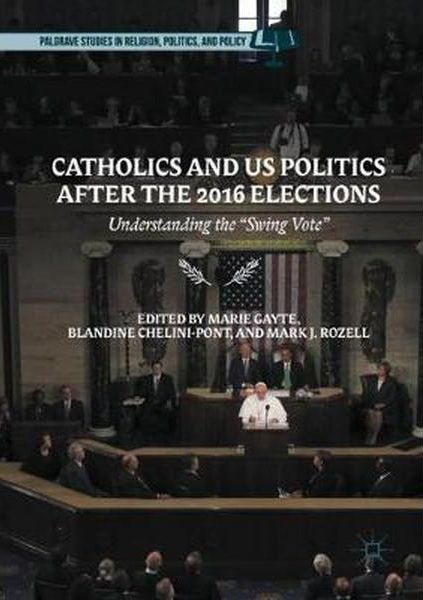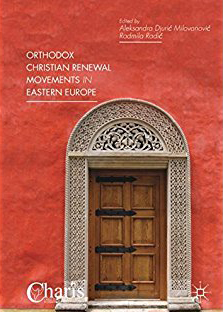
With Religion Watch having become available for free, one of our goals has been to make available online those years of our newsletter that had only been published in print (i.e. pre-1998 issues). Thanks to the patient work of associate editor Jean-Francois Mayer in designing and updating the files, and to Frances Malone, who patiently scanned several years of archives (and also to Larry Iannaccone for donating his back issues of RW), it is our pleasure to announce that the years 1990 to 1997 are now available as scanned PDF documents on our archive site. They can be accessed from https://www.rwarchives.com/archives/pdf-1985-1997/. There are still a few missing issues that we hope to be able to add to the list soon. In the upcoming months, we also hope to be able to add the issues for the years 1985 to 1989 as well. Most of the content of the issues can be explored by using the site’s search tool.


Rozell writes that the campaign to draw in Catholic voters for Trump was relatively successful while Clinton had limited appeal and even Democratically-inclined Latino Catholics did not turn against Trump in significant numbers. Other contributors flesh out this trajectory, noting that the effect of U.S. Catholic bishops and the Holy See on Catholic voting was weak, while the decade-long Catholic-evangelical alliance on such issues as abortion may have had more influence, as well as working-class concerns persisting in the industrial northern cities. Other chapters look at the various yet ultimately weak efforts of the Catholic left to find sympathetic voters, and the possible split in Catholic conservative ranks over the Trump presidency.
O’Brien notes that other behaviors (even something as trivial as not showing up for Friday prayers on time) are adopted by these young men to show that they value individual freedom and a certain amount of rebellion like other youth even while they maintain their faith. Dating is a particular area where this tension between following teen norms and religious observance seems to break down; ambiguity and understatement are the preferred means of dealing with this fraught period. They might use Islamic terminology, linking spirituality and romantic love, but tend not to apply Islamic law directly to their relationships (though they largely refrained from premarital sex). This low-key approach is also seen in the way these Muslim youth tend to downplay their Islamic identities in public (even though their mosque called for a more extroverted approach to their religion in their daily lives), though this is partly to fit in with other young people and partly due to concerns about harassment from revealing their faith in society. In the conclusion, O’Brien revisits these young men and finds that they have been able to manage this tension between (now) emerging American adulthood and Islamic identity. He ends by calling for mosques to provide more spaces for young Muslims to work out these tensions in forming their identities.

The “church culture shift” that she observes taking place is especially evident in upper Midwestern Lutheranism, which—as Freudenberg acknowledges—could cast doubt on her contention that this is a denomination-wide development (there are several church cultures in the ELCA). But she also studies the discourse and actions of the denominational leadership and finds that they are attempting to delegate authority toward the congregational and regional levels. At the same time, she argues that church leaders are seeking to retain Lutheranism’s liturgical and confessional nature (most clearly seen in the leadership of ELCA’s Presiding Bishop Elizabeth Eaton), which may conflict with decentralized and lay-led currents. Such maintenance of the “core” identity allows (at least in Lutheranism) for “messiness” and experimentation on the congregational level, or tension between “structure and anti-structure.” Critics may note that she does not pay much attention to how the influence of seminaries and clergy formation and the ever-present ideological “culture wars” are shaping the denomination. Still, Freudenberg’s work represents an important effort to interpret changes that are evident throughout the mainline and what they may mean for the future of this branch of Protestantism.

There were in fact influences from Reformation movements and similar movements formed by people who borrowed from evangelical groups while continuing to consider themselves as Orthodox. The challenge of missionary activities by movements of Protestant origins was felt as a call to renewal by some priests and faithful, even if it took time, as one can see in Bojan Aleksov’s study on the reactions of the Serbian Orthodox Church to the spread of the Nazarenes (an Evangelical movement not to be confused with the American denomination). As shown in a chapter by the editors, the God Worshipper movement in Serbia largely started as a spontaneous, grassroot phenomenon, first seen with suspicion by many church officials. Several chapters explore different aspects of this movement and its impact on the Serbian Orthodox Church, covering the entire second part of the volume and making those chapters into an ensemble that forms the core of the book. The God Worshippers attended church services regularly, but also met on Sunday afternoons or evenings and on saints’ days since, “although they resolutely claimed that they belonged to the Church and that they respected the Church hierarchy, only outside the churches could they freely reveal and fulfill their religious needs,” as Dragan Ašković writes in a piece on the prayer chanting of the God Worshipper movement.
Like similar movements in other denominations, the challenge for the established church was to draw benefit from the stronger piety they inspired while avoiding the fall into doctrinal errors or practices seen as un-Orthodox. In fact, founders of some movements ended up leaving the church and continuing with independent movements. Despite the hiatus of the Communist period, some movements have managed to survive those hostile decades and to remain sources of renewal for their national churches. Corneliu Constantineanu finds that such is the case with the Romanian Lord’s Army, whose birth was closely linked to a new appreciation of the direct access to clear translations of the Scriptures available for all believers, and which “today affects more than a million people in all parts of Romania.” Similarly, the Brotherhood of Theologians Zoe (founded in 1907) has become “one of the most, if not the most, influential religious organizations in twentieth-century Greece.” It was devoted from the start to “the expansion of Orthodoxy within Greece” while remaining outside denominational control. Still, it has been accused by a famous former member, theologian Hristos Yannaras, of having been influenced by Protestant sources and of having deviated from a genuinely Orthodox spirit. Zoe was influential, but remains today a shadow of its own self. Amaryllis Logotheti describes its ideology as having been one of “conservative modernization.” All these movements, each in their own way, have brought new impulses to Orthodox Church life in their respective countries, impulses that in some cases have lasted to this day.